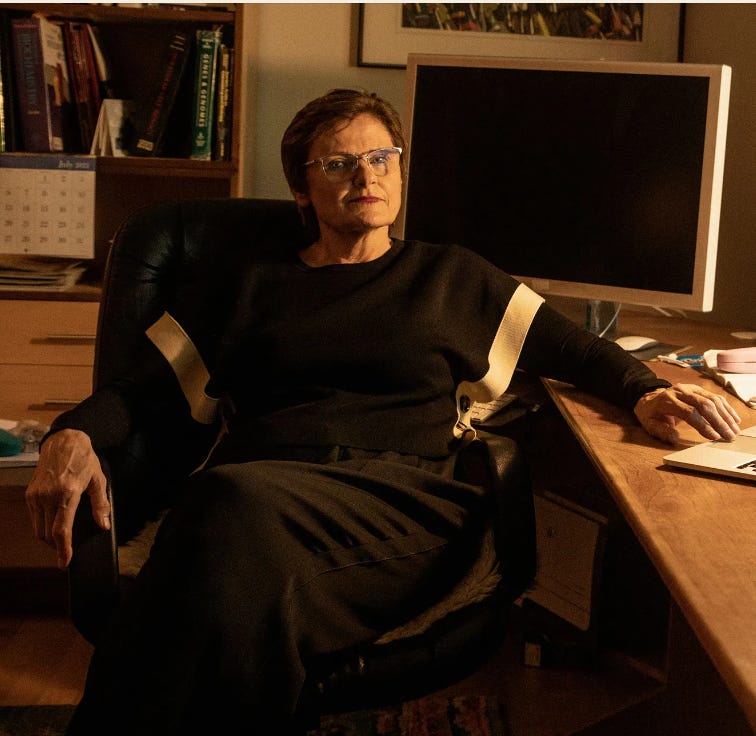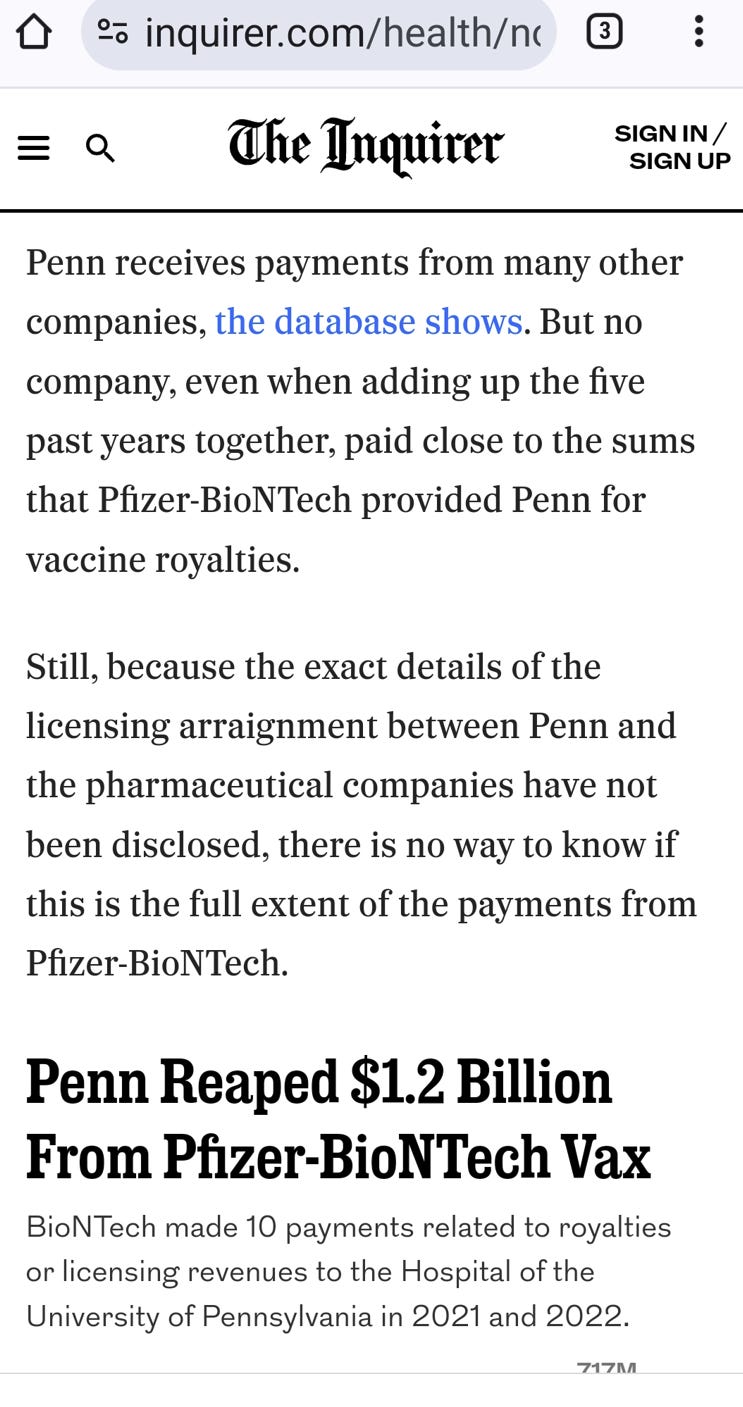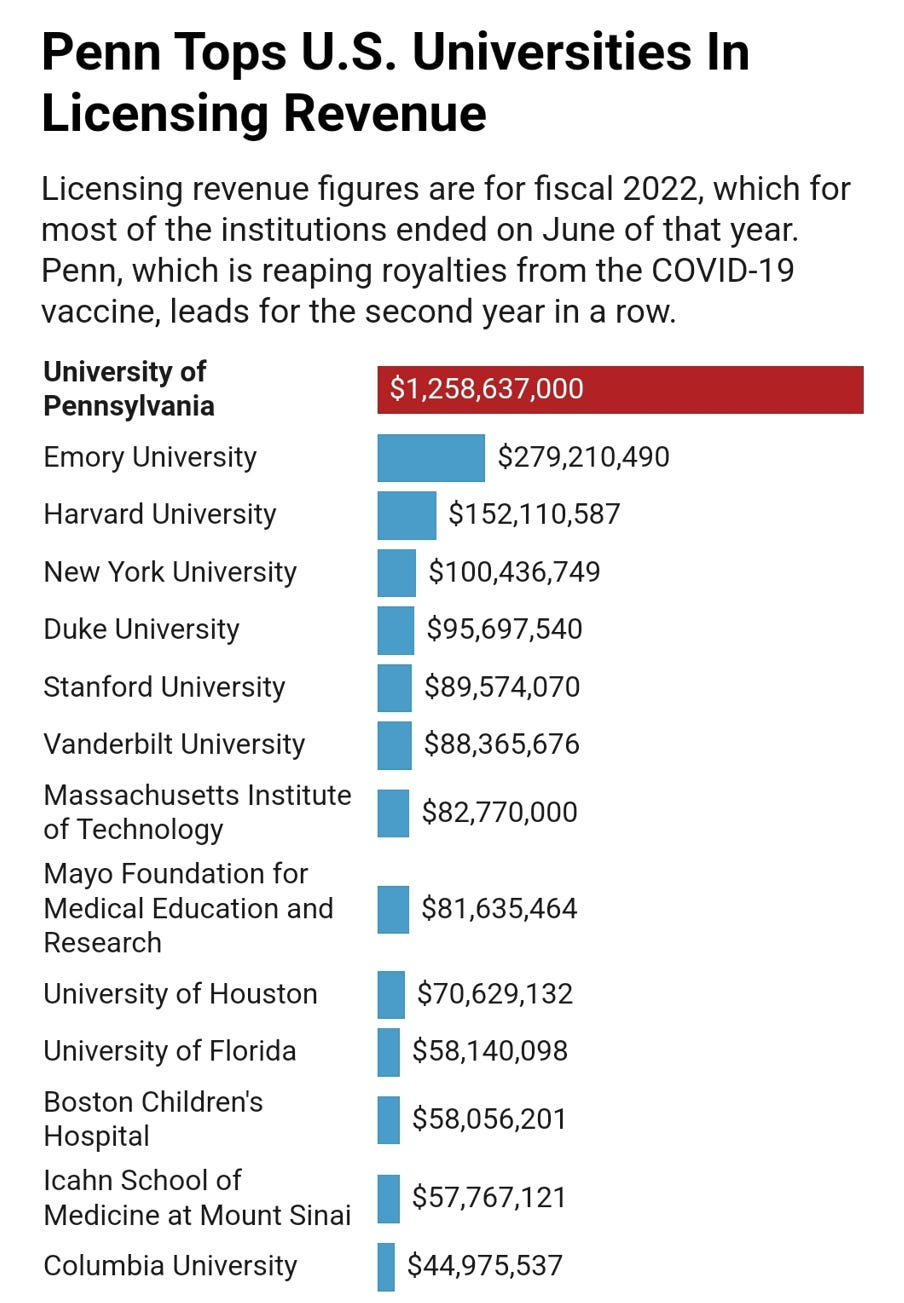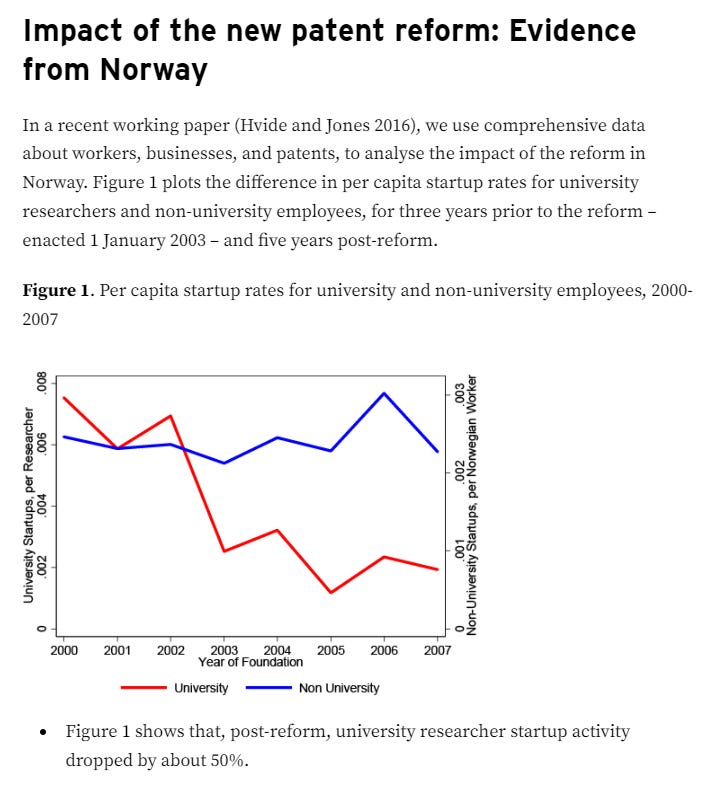Current federal law allows universities to patent discoveries made with federal funding, but numerous empirical studies show that innovation is greater when researchers have more control over their own work. We should amend the law so that researchers and inventors have more of a direct right to patent their work and take it to market.

Introduction
In the Bayh-Dole Act of 1980, Congress stated that it wanted “to ensure that inventions made by nonprofit organizations and small business firms are used in a manner to promote free competition and enterprise” (35 U.S.C. 200). Thus, with a few narrow exceptions, “each nonprofit organization . . . may, within a reasonable time after disclosure . . . , elect to retain title to any subject invention” (35 U.S.C. 202).
This law was passed because Congress thought the prior status quo was unacceptable (i.e., government agencies would often take control of patents without actually commercializing the discoveries, or at least so was the perception).
But note who ended up with the presumptive right to the patent here: Not the professor(s) who did all the actual research (as would be the case in some countries), but the universities that employed them.
At least, that is how Bayh-Dole has typically been applied in practice. The Supreme Court’s main case here actually held that Bayh-Dole did not disrupt the normal principle that inventors own their own inventions. Nonetheless the Supreme Court said that universities can take over patent rights when they “enter into agreements with their employees requiring the assignment to the university of rights in inventions.”
Which is what universities then do.
Technically, universities are expected to “share royalties with the inventor,” but the exact amount isn’t specified (35 U.S.C. 202(c)(7)). And under Bayh-Dole, the actual researcher/inventor can get access to the patent rights, but not without approval from both the university and the federal agency in question:
If a contractor [i.e., university] does not elect to retain title to a subject invention in cases subject to this section, the Federal agency may consider and after consultation with the contractor grant requests for retention of rights by the inventor subject to the provisions of this Act and regulations promulgated hereunder.
35 U.S.C. 202(d).
We need to rethink how all this works. It isn’t fair to researchers that they are put in a position where they have so much trouble getting a patent over their own work. Substantial scholarly evidence shows that we would likely get more innovation from giving university researchers the presumptive right to patent their own discoveries. To be sure, they could choose to assign that right to university tech transfer offices if so desired (some university TTOs do a great job). But researchers shouldn’t be forced to wait for TTO approval or to agree to a TTO’s terms that were too exploitative.
The Katalin Karikó Case
By now, most people have heard the story of how recent Nobel winner Katalin Karikó was driven out of academia due to the unpopularity of her work on mRNA.

As she told CNBC:
“I was demoted four times,” Karikó, 68, tells CNBC Make It of her time at the University of Pennsylvania, where she was a research assistant professor before eventually being pushed out.
Karikó says her interest in mRNA, the genetic messenger that sends DNA instructions to make specific proteins, was often dismissed. While she thought it had “promise,” many scientists didn’t see her vision, which made it difficult for her to obtain grant money, she says.
Thus, I was intrigued to see this article noting that the University of Pennsylvania has now made some $1.2 billion in royalties from patents on Karikó’s work, and is bringing in far more royalties than any other US university:


Wait a minute . . .
How did Penn make 14 times as much money as Stanford, almost all from research done by someone that Penn itself drove out of academia over a decade ago? [I’m also curious about Emory, now that I see this chart…]
Weird, right?
The thing is, Penn kept the patents on Karikó’s research. Although she didn’t get NIH grants herself, she was working in Weissman’s lab, and their seminal 2005 paper does credit 3 NIH grants, which would invoke the Bayh-Dole regime.
Look what happened next, as reported by the Daily Pennsylvanian (an excellent student newspaper that was founded in 1885):
Penn was eventually awarded a patent for the modified RNA developed by Karikó and Weissman, enabling the University to have the final say in how the patent would be licensed. To control the direction of future research, Karikó and Weissman sought to purchase the patent themselves — but it was sold in its entirety to a different company. [!!!]
Karikó requested to be reinstated to a faculty position at Penn in 2010 but was initially rejected. Karikó wrote that administrators told her that she was “not of faculty quality” — citing how individuals who have previously been demoted can not be promoted back to the faculty track.
In other words, Penn did everything within its power to discourage Karikó’s research—it demoted her, deprived her of lab space, and eventually forced her out.
Nonetheless, it kept the patents on the work [thanks, Bayh-Dole!], and refused to sell the patents back to her or Weissman [thanks again, Bayh-Dole!].
And now, because of its exploitation of Karikó and the Bayh-Dole system, Penn is raking in many times more patent royalties than any other university in the country.
We needn’t believe that universities are patent trolls (as is sometimes claimed) to think that this is unfair and unethical.
Moreover, if the goal of Bayh-Dole is to reward universities for encouraging innovative research—well, Penn did nothing to facilitate Karikó’s research. Quite the opposite. Indeed, if Penn had only been slightly more successful in its goal of driving Karikó out of research in the 1990s, there would likely have been no discovery to commercialize in the first place!
Penn doesn’t deserve a penny from Karikó’s work, let alone $1.2 billion+ dollars. (PS: there are likely many other cases where a well-endowed university doesn’t deserve to be enriched by a professor’s unilateral discovery.)
In many cases, of course, the university provided a hospitable environment for researchers to do their best work. But universities are already getting reimbursed for much of that through indirect costs. For example, Harvard’s federal indirect cost rate is currently 69%. If Harvard already gets 69 cents on top of every dollar that a researcher brings in for their own lab, why should Harvard then get the right to control the patent on any discovery out of that lab? Harvard could get a reasonable stake in the patent (say, 10%) without deserving control.
We should fundamentally rethink the way that Bayh-Dole apparently lets universities take control over a researcher’s discoveries. There are many reasons to think that this university privilege under Bayh-Dole only leads to inefficient and exclusionary practices. As one well-informed observer wrote:
Nothing in Bayh-Dole makes tech transfer easier, go better, or be less costly. No one jumps with joy that an invention disclosure has shown up identifying federal support. Bayh-Dole–at least as practice has developed citing Bayh-Dole–is just prissy deadlines for meaningless compliance. . . . What is the proper wording for the government rights citation in a patent application? How soon must one file an election to retain title? To file a patent application? . . .
No one asks whether all the tech transfer effort has resulted in timely practical application–use with benefits available to the public on reasonable (competitive) terms. No one asks whether product improvement and applications in various fields have taken place in a reasonable (competitive) time. . . . No one asks whether supply meets public needs.
Dates of first commercial sale or use? Nope. Is the pricing of product reasonable? Nope. Is the university properly using income earned with respect to subject inventions? Nope. Has a university flowed down the nonprofit patent rights clause (with its restrictions on the use of income earned) in exclusive licenses that grant all substantial rights in a subject invention? Nope. No one advises universities to get these things right. No one even audits university reports of subject invention utilization to see that they are even accurate and backed by documentation.
Moreover, imagine if we applied the same system to researchers’ publications and articles. As Litan and Cook-Deegan point out (p. 66 here):
If universities applied the same model to faculty research, it would mean that all faculty members would be required, by contract, to first obtain the approval of a central “publications office” that would coordinate the submission of articles to journals and books to publishers. It almost goes without saying that faculty would not stand for such an approach to their publications, nor would universities voluntarily adopt it for fear of frustrating the dissemination of research results to the academic community and the wider public.
Hard to imagine. And hard to imagine why we thought this was a good idea as to a subset of academic articles (the ones that contain a new discovery/invention).
The Evidence on Bayh-Dole Versus Professor’s Privilege
A number of papers have found that the 1980 Bayh-Dole Act improved innovation, patenting, etc. But that’s in comparison to the old system in which the federal government often or usually took control over inventions and patents. Those papers tell us absolutely nothing about whether universities should have control over professors’ discoveries instead of the professors themselves.
Over the past few decades, some European countries have switched from giving professors the right to patent their own work (“professor’s privilege”) to something more like the Bayh-Dole system (in which universities have the patent rights). It’s not clear what inspired those countries to do so, other than being fooled by the incipient academic literature on how switching to Bayh-Dole increased innovation. As Kenney and Patton wrote in 2009, “It is unfortunate that some policy-makers now subscribe to a belief that passing new regulations mimicking U.S. university patent ownership models will deliver entrepreneurship and new ‘Silicon Valleys,’ even to the point that the most successful university technology-based entrepreneurial region in the world outside the United States – Cambridge, England – abandons its successful model.”
The evidence to date suggests that those countries moved in the wrong direction.
While university tech transfer offices (TTOs) can add some value in terms of negotiating power, connections with venture capitalists, and the like, I haven’t been able to find any empirical evidence that universities and TTOs should be allowed to set the terms on which a researcher can use her own discovery.
It’s almost certainly better for innovation to give professors the right to patent their own work, likely because they have the strongest interest and ability to carry that work forward.
The evidence:
First, Hans K. Hvide and Benjamin F. Jones’ 2018 AER paper looked at what happened in Norway, “which in 2003 ended the ‘professor’s privilege,’ by which university researchers had previously enjoyed full rights to new business ventures and intellectual property they created. The new policy transferred two-thirds of these rights to the universities themselves, creating a policy regime like that which typically prevails in the United States and many other countries today.”
Hvide and Jones were fortunate to have extensive data on “all start-ups in the economy,” and full data linking university researchers to patents.
The results? An “approximate 50% drop in the rate of start-ups by university researchers.”
From a column about their paper:

Not only did the rate of university startups drop by 50% when Norway moved from “professor’s privilege” to something more like Bayh-Dole, the quality went down too! That is, it’s not as if universities became more selective and only moved forward with the best ideas. To the contrary:
After the reform, startups by university researchers become less likely to survive and grow more slowly. Meanwhile, university-based patents receive fewer citations. Thus, not only does the quantity of commercialisations by university researchers decline, but there are declines in several quality measures as well.
Second, a paper by Ejermo and Toivanen looked at Finland’s choice to abolish the professor’s privilege in 2007, and instead let universities have priority over patenting rights (just as in Bayh-Dole). They found that in matched samples, there was a “drop in academic patenting” of 46 percent. They say that “our and others’ results call into question whether the European reform of the professor’s privilege was good innovation policy.”
Third, a paper by Czarnitzki et al. (2014) looked at what happened when Germany “transferred patent rights from faculty members to their universities” back in 2002. The overall finding: “For professors who had existing industry connections, the policy decreased patenting, but for those without prior industry connections, it increased patenting. Overall, fewer university inventions were patented following the shift from inventor to institutional ownership.”
Fourth, yet another paper (Martinez and Sterzi 2020) found that across many European countries, there was “a significant decrease in the technological importance of university inventions and their overall value in countries abolishing the professor’s privilege.”
In short, the empirical evidence consistently shows that it is better for innovation and entrepreneurship when researchers are able to move forward with their own discoveries rather than having to depend on (and negotiate with) university offices.
It isn’t surprising that it’s better when inventors have more control
People tend to do better when they have skin in the game, and when they can move forward with their own ideas rather than having to forfeit control to a bureaucracy that may or may not be willing to exert effort to develop those ideas commercially, and that might even want to pursue its own financial benefit to the exclusion of the researcher.
Do university TTOs provide valuable advice and connections to university researchers? That is definitely true in some cases (e.g., universities such as MIT and Stanford that have well-developed offices). But it probably isn’t true much of the time. An investor I know wrote the following to me as a couple of horror stories he had personally observed:
I once developed a long-term corporate innovation partnership with a leading university in a very progressive state. The negotiation of IP terms took two years, despite our intention to invest $40 million. The agreement, which the chancellor would have signed within days, was delayed by internal bureaucracy. The endless committees, opinions, and obstruction by unionized and taxpayer-funded employees were baffling and undermined progress.
I also know a former Chair of Medicine at a prestigious medical school who was coerced by his local TTO for 12 months and ~$300,000 in legal fees to retain control of his invention. The TTO initially demanded >90% of the company’s equity for the university. But his lawyers were worth every penny: he spun out the company with >80% of the equity and is partnering with a pharmaceutical company to develop a new blockbuster drug that could save thousands of lives per year.
Moreover, respondents to a UK survey overwhelmingly thought that “university TTOs lack industry expertise and do not move the speed a startup needs. Unfortunately, few founders point to any examples where the TTOs’ alleged advice or networks either helped them or even existed at all.”
Which makes sense. As Litan and Cook-Deegan have pointed out (p. 67 here):
Perhaps most recognized is the incentive for monopolies to reduce output. In the university commercialization context, this tendency manifests itself in the limited attention, given limited resources, that TTOs have to give to all innovations developed by university faculty, and the inherent need therefore to focus on only a few potential “winners.” But with talent and experience no better than private venture firms, and without the same or similar gain-sharing incentives for success that motivate general partners of VC firms (who typically take 20 percent of the profits of the enterprise), there is no reason to believe that the TTOs can be any more effective than the market itself in determining the true winners. This leaves potentially many innovations by faculty members not given favored treatment by the TTO staff in bureaucratic limbo until someone in that office can give them proper attention, if ever. Indeed, the well-known tendency toward bureaucracy and inefficiency of monopolies, to which TTOs certainly are not immune, aggravates this problem.
In short, Bayh-Dole should be restructured so as to be more consistent with the scholarly evidence as to what produces more entrepreneurship and innovation, and so as to prevent the exploitation that Katalin Karikó experienced.
Conclusion
One provocative recommendation is that Congress should think about banning universities from trying to make researchers sign over all rights to their own inventions/discoveries, and instead recognize (as did the Supreme Court) that actual inventors have the presumptive right to patent their own work.
Congress could also incentivize universities and researchers to work together on a uniform, streamlined agreement that would give the actual researchers, say, an automatic 80% stake in their own inventions/discoveries. Researchers should have the option of working with university TTOs if they so choose (as many of them will do), but they shouldn’t be forced to do so. Universities (as well as the government) should at most be entitled to a reasonable percentage of royalties (say, 10% each), not to entire control.
More broadly, Congress should commission an independent audit of Bayh-Dole compliance, practices, and outcomes. Such an audit could be transformative—it would likely show the inadequate outcomes, the overbearing bureaucracy, and the outcomes that disadvantaged inventors or the public. With such an audit in hand, Congress would have the information necessary to rethink innovation policy at a deeper level.